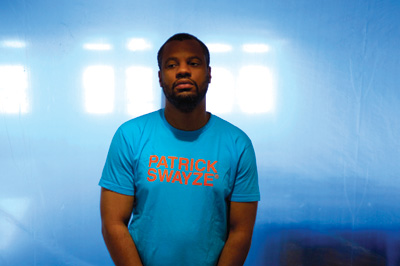|
||
      |
Peer Review ::
Unromancing the Renaissance
Curator Hamza Walker, AB’88, handles the down-to-earth details of alienating art.
Hamza Walker’s worst nightmare, he says, is “realizing that you are still in Cobb Hall where you took all your undergraduate classes. ... And I live it every day!” Walker, whom the New York Times has labeled one of the seven most influential curators in the country, is director of education and associate curator for the Renaissance Society, the noncollecting museum of contemporary art on Cobb Hall’s fourth floor. Nightmare? Walker’s broad smile betrays his enthusiasm for his home turf.

Founded in 1915 at the University, the independent Renaissance Society has helped introduce the city to the works of such artists as Pablo Picasso, Piet Mondrian, Ferdinand Leger, Bruce Naumann, and Cindy Sherman, and established itself as a champion of vanguard art. Recent exhibitions have included latter-day stars Felix Gonzalez-Torres, Helmut Jahn, Kara Walker, and Michel Auder.
This summer Walker stood in the middle of the Renaissance’s 3,500-square-foot, single-room exhibition space beneath Cobb’s north roof, taking a look at the final clean-up from the latest show—Rebecca Morris’s abstract paintings. He’d already envisioned the layout for five gigantic video screens needed for the next installation, a collaborative work by Berlin-based artist Peter Welz and choreographer William Forsythe, tentatively titled All the Pretty Corpses, opening in November. Logistical matters—where to place the screens, how high to turn up the volume, when to dim the lights—account for a significant part of his work, Walker explains. “I have a very nonromantic view of whatever curatorial labor has become. In working with artists, it is not simply about the level of content; it also involves discussions about the technical requirements for a given piece.”
Born in New York City, the son of a jazz musician and a mother who worked several odd jobs, Walker later moved with his family to Baltimore, where he grew up as “a young punk, full of rage.” “What could be more alienating than that?” he asks, “the time—the seventies, the place?” Today his favorite artists work to alienate the viewer. “Alienation,” he says, “turns me on.” People who tell him they “just love” contemporary art make him suspicious. “I distrust them immediately,” he says. “I don’t inherently like art—that’s not a given for me.” At Chicago, majoring in art history, he visited the Renaissance regularly. “But all the while I held contemporary work in disdain,” he says, “so clearly there was some Freudian dynamic at work.”
Coming to terms with his contempt informed Walker’s appreciation of contemporary art. “The work is not the source of my disdain, or my dissatisfaction or my frustration; the work can only prompt it.” He actually welcomes contemporary art’s illegibility and hermeticism, and the frustration it can cause a viewer. “I do have a passion for it,” he says, “but it’s driven in equal parts by love and disdain.”
He never imagined becoming a curator. “I fell into this,” he says. He didn’t anticipate making a career of his studies, but he discovered that “after college, any kind of sustained intellectual nourishment about contemporary work is very hard to find, unless you are with other artists.” So he focused on becoming a member of the artistic community, working as a public-art coordinator at Chicago’s Department for Cultural Affairs and volunteering at the former Randolph Street Gallery before he joined the Renaissance Society in 1994.
Today Walker, a tireless traveler and networker, has become known beyond Chicago’s art scene not only for his innovative curatorial work but also for his wide-ranging thinking and writing about contemporary art, published in industry magazines and exhibition catalogs. The New York Times called him “one of the museum world’s most talented essayists” and lauded his “storytelling approach to shows.” Walker is skeptical of the flattery, stressing that he can’t stand narrative art. He wants his shows to “function critically,” he says, commenting on “how we live now.”
This year he received the Menil Collection’s Walter Hopps Award for curatorial achievement, given to a curator in early to mid-career. But while he denies being the art world’s “dramatic figure” and “rising star,” as local and national newspapers have described him over the past few years, he admits that now he can’t imagine doing anything else. “If you take a domesticated animal out in the wild, it cannot survive. That’s what I feel like. This other world, where people have 9-to-5 jobs, that’s the wild.”